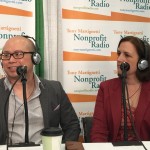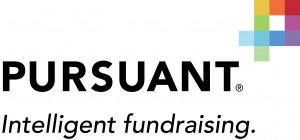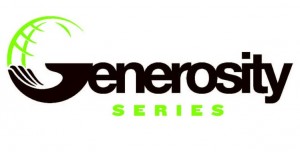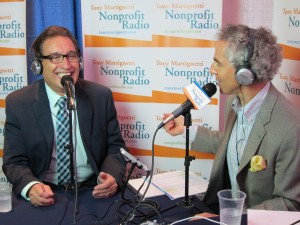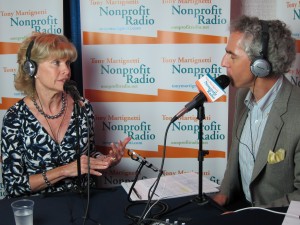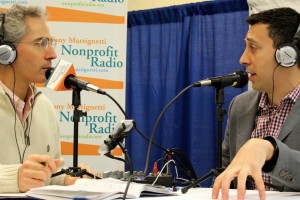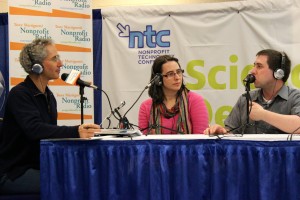Big Nonprofit Ideas for the Other 95%
I love our sponsor!
Do you want to find more prospects & raise more money? Pursuant is a full-service fundraising agency, leveraging data & technology.
Listen Live or Archive:
- On Fridays at 1pm Eastern: Talking Alternative Radio and tune in.
- Listen to the September 4, 2015 archived podcast.
My Guests:
Yasmin Nguyen & Sheri Chaney Jones: Video Storytelling
In a crowded video internet, how do you tell that compelling story so your message moves others to take action? Sharing their smart strategies are Yasmin Nguyen, CEO of VibranceGlobal, and Sheri Chaney Jones, president of Measurement Resources. We talked at NTC, the Nonprofit Technology Conference, hosted by Nonprofit Technology Network (NTEN).
Maria Semple: Don’t Tell MY Story
The right to be forgotten. Maria Semple explains last year’s EU opinion that Google must remove outdated links from search results. What’s the impact on your prospect research? Also, your donors’ right to privacy. Maria is our prospect research contributor and The Prospect Finder. (Originally aired 6/13/14)
Top Trends. Sound Advice. Lively Conversation.
You’re on the air and on target as I delve into the big issues facing your nonprofit—and your career.
If you have big dreams but an average budget, tune in to Tony Martignetti Nonprofit Radio.
I interview the best in the business on every topic from board relations, fundraising, social media and compliance, to technology, accounting, volunteer management, finance, marketing and beyond. Always with you in mind.
Sponsored by:
Processed on: 2018-11-11T23:23:17.625Z
S3 bucket containing transcription results: transcript.results
Link to bucket: s3.console.aws.amazon.com/s3/buckets/transcript.results
Path to JSON: 2015…09…256_tony_martignetti_nonprofit_radio_20150904.mp3.139019840.json
Path to text: transcripts/2015/09/256_tony_martignetti_nonprofit_radio_20150904.txt
Hello and welcome to tony martignetti non-profit radio big non-profit ideas for the other ninety five percent. I’m your aptly named host. Oh, i’m glad you’re with me. I come down with a case of her panji nna if my mouth had to say the words you missed today’s show video storytelling in a crowded video internet, how do you tell that compelling story? So your message moves others to take action. Sharing their smart strategies are yasmin win, ceo of vibranceglobal and sherry cheney jones, president of measurement resource is we talked at ntcdinosaur non-profit technology conference hosted by non-profit technology network and then and don’t tell my story the right to be forgotten, maria simple explains last year’s you opinion that google must remove outdated links from search results what’s the impact on your prospect research also your donors right to privacy? Maria is our prospect research contributor and the prospect finder that originally aired june thirteenth of last year on tony’s take to the ntc videos responsive by pursuant full service fund-raising data driven and technology enabled, you’ll raise more money pursuant dot com here are yasmin win and sherry cheney jones with video storytelling welcome to tony martignetti non-profit radio coverage of ntc twenty fifteen the non-profit technology conference we’re at the austin convention center austin, texas we’re kicking off our coverage with this interview. Are my guests now? Are jasmine win and sherry cheney jones welcome. Thank you. Thank you, it’s. Good to be here. They’re seminar topic is stop shooting videos. Start unlocking stories. Jasmine win is founder and ceo of vibranceglobal and sherry cheney jones is president of measurement resource is let’s start sherry, what are non-profits not doing quite a cz? Well as they could with video interviews, storytelling? What? From my perspective, because we help non-profits measure and communicate their impact in value, they often are focusing on their impact. So how are they changing lives and changing circumstances there, too focused on the activities. So, really understanding what your true impact is and telling your stories from there, and you’re trying to elicit really heartfelt story telling stories. You know, emotional, we want emotional impact. Okay, what would you have you have? You know, i think that a lot of times we focus so much on the technology, the process of doing video and also the questions that we ask people, and so we don’t focus enough on the connection, and really, when you are able to provide a space for someone to open up, to feel that they can speak about their passion, be grateful, they then create that connection that we can then capture and witness through videos and so it’s that focus on that connection rather than just the information or that exchange. Now, as we are today, you’re asking people to get in front of lights and cameras or and mike’s on dh and open up yes, men. How are we going toe start this process first, let’s start with how do we find the right people? And then we’ll get into coaching them and and getting their best performance and storytelling out of them. But how do we find the right one? Yeah, absolute tony that the key thing is selecting the right people, and that starts with being mindful of who your audience is. You know, we found that the most impactful, relevant, ah person to interview talk with are a representation of our audience. So, for example, for appealing to a donor’s, then it be great to have a financial supporter donors to be able to speak in their language in the same mindset for them to connect and relate. So think about the group’s. We want this interview to be meaningful for and select people from that constituency. Right? Volunteers, donors, board members. Yeah. Ok. And someone who’s were well respected. Who’s. Our ticket who’s also a very passionate and a champion of of our particular cause to be able to speak for us but also at the same time, carry the torch for our audience so that they can connect with them. Sure, anything you want to add to finding the right person is sure. I always say, think about your wise. Why do you do it? You do, but not just why does your organization do what it does? But why does your funders fund you and whitey here? Participants participate. And when you’re finding people to tell your story, you want to make sure that you are covering those three perspectives. Okay, three wives. The three wise yet three wise men know e wise? Yes, different wise. Okay, sure. Let’s, say with you now. So we found the right people. How do we start the process of making them? Comfortable evoking the really heartfelt emotion that we’re tryingto chief? Sure. Well, i will actually default to us because he’s really good at that, you know, i’m i’m the one that helps you create the content think about what you should be eliciting and he’s when it does the great interviews, maybe you’re more on the on the production side. I’m more on the defining what what questions? You should be asking what impact you should be drawing out of them stuff like, okay, we’ll come to you very shortly. Okay, okay. We got plenty of time together. Twenty five. Just great. Yeah. You know, for someone to be at ease. You really it’s it’s? Really? About how you think about the interview or how you think about being on video? A lot of times, people focus on the act of, you know, being on camera so they feel like they’re being evaluated. They’re being judged or in an interview, maybe you think of, like, a job interview or or some others where they have to perform and they have to be perfect. And what that does is it raises this level of anxiety where you have tio feel like you have to know, not necessarily be your best to be your most authentic. Authentic. Yeah, you’re you’re going to be your best if you’re most if you you’re most authentic, you just you write which is hard to get and even on steven instill videos, pictures it really is okay? Yeah. How are we gonna do so down? So so part of that is in the initial invitation is instead of hey, can you do a testimonial keen? And you come on camera and do a video it’s about framing it in a way that helps them give instead of being put in a position to perform. And so what i mean by giving is, you know, i’d like to invite you to come and share your story so that we can help inspire others like you. You know, we we want to put you in a place where you can be of service to others, and when you’re in that mindset of being of service, to be able to share your experience and insight so that it can help others, it takes that pressure off because now it’s about your own story, your own experience and there’s no. Right or wrong. And so that that’s the first step is the mind set piece. Okay, so let’s try to avoid characterizing it as testimonial. Do you know, do something that way. Put a label on right or even an interview? It should be more of a conversation. And i find that mom i doing so far, you’re doing great. My failing is a failing grade know you’re at least a b plus or something. You’re doing great. You’ve done this a few times. I have securities right already. Absolutely cool. Yeah. All right, s so tell me more. Yeah, so? So. So that’s the first step is setting up the frame for for what? That experience is like giving them information so that they feel prepared, you know, even some questions. Not necessarily for them to prepare a script, but for them to at least be a tease to know what to expect, that there’s not going to be this sort of curveball, or they’re gonna be blindsided because people have a lot of anxiety around, you know the uncertainty. And so that that’s another element. And then once you actually get into the session, then then it’s really about creating that space. I go through a specific routine if i find that someone’s either really nervous or they’re very tense, where we do an exercise called a ci gong slap, and what that is is where you basically take your hand and one hand and you slap the part of your front part of your arm all the way back to up to your chest, and then you do on the other side and then down to your legs and then back up through your back and then on your head as well. You do that a couple times having how hard you’re slapping, just just so just like just like this. So you’re going back like this and that and then down to your chest and then back-up and what you’re doing is you’re activating the various different meridian parts and your body, your head too as well, too. And then once you do that a couple times, you’ll notice this sort of tingle. It just activates the energy and yourself. And so that’s physically gets you ready. Another gong xi gong slap. Yeah, yeah, you can google that nok will be on youtube. The other parties is also getting you into what we call the vortex or the zone or, you know, the peak performance state and so, you know, i listen to some music, so whatever music kind of gets you going here, the whole goal is to are we asking the person i interrupt all the time, you know, that’s bad that’s, bad technique, a weapon? You don’t have a conversation, really? So we’re asking the person in advance, what’s your kind of music or bring bring some of your favorite music, you’re going bring some of that, but even before the actual interview, i will take time to have a phone conversation, just tow, learn about that, build that report so it’s not. We’re not meeting for the first time on camera and, uh, and that way, we feel like we’re friends and i can ask them about different things, so the whole goal is to get them out of their head and into their hearts, because when they start speaking from the heart when they start opening up yeah, that’s when the magic happens, outstanding. All right, you’re tuned to non-profit radio tony martignetti also hosts a podcast for the chronicle of philanthropy fund-raising fundamentals is a quick ten minute burst of fund-raising insights, published once a month. Tony’s guests are expert in crowdfunding, mobile giving event fund-raising direct mail and donor cultivation. Really, all the fund-raising issues that make you wonder, am i doing this right? Is there a better way there is? Find the fund-raising fundamentals archive it. Tony martignetti dot com that’s m a r t i g e n e t t i remember there’s, a g before the end, thousands of listeners have subscribed on itunes. You can also learn maura, the chronicle website, philanthropy dot com fund-raising fundamentals, the better way. Surely now let’s, come to you with questions. Durney um, we really jasmine alluded to a little bit, but the types of questions where you’re aware your expertise comes in. Sure in terms of thinking about what? Why are you doing this video? I’m sorry i called you jasmine. Jasmine? Pardon me. Sorry about that. Yes, you have been eluded. So what’s the purpose of the video you’re shooting. Who is your audience? What do they care about? And what we know about is although fund-raising is up from where it was pretty great recession levels, people want to know that there their money is actually making a difference. So no longer can we just say, oh, here’s a cute kid, i’m going to tell you my story about, you know, my family people really want to know that there’s a collective impact going on that there’s, you know, in the measurement world, the outcomes that you’re achieving. So you want to think about what are those outcomes that you know that people want you two to be showing and then making sure your interview questions are addressing those? So people are telling their stories around how they experience the outcomes that you are saying that you’re achieving, how they’re experiencing a perfect and we’re going to get really kind of personal, right? Like how i saved your life improved your life, help your child, you know, etcetera, yeah. So, you know, we have a list of twelve outcomes that typically non-profits air achieving, like increased knowledge increased, gilles, you know, maintenance of new behavior, reduction of undesirable behavior. So no, those going in before you start asking your questions and let your interview we know that you’re going to want to know about, you know, how did this program increase your knowledge or help you get a job or, you know, decrease your risk for heart disease or whatever it is that you’re non-profits doing, make sure the questions are aligned with those important outcomes. Should we stay away from giving exact questions? You will be asked one, two, three, four, because i find in doing my show that that then leads to scripted questions, lead descriptive answers, and and that’s not from the heart, that’s from appearing like memorized so so sherry but we want to give them topics, right, but not exact questions is that is that the best practice or what? Either either. Yeah, i found that i could give them some questions and with a disclaimer that, you know, these are some of the similar types of questions that will be asking and then also explain to them how to prepare. So just think about some bullet points or just some stories that may be relevant, but not necessarily prepare a script per se as well to so that that, uh it alleviates the anxiety, but you’re also making sure that they don’t have a prepared answer. Percent. Yeah, yeah. Like i said, then that’s not that’s, not the impact you’re gonna want. Um, all right, anything else, before we get to the actual either of you need anything else before we get to the actual session with mike’s and lights and cameras that we should be thinking about? We didn’t talk about yet, you know, i think that’s that’s pretty much covers it for now. We’re going to go and dive a little bit deeper into ours session then during that time. Yeah. Oh, well, i mean, there’s stuff you’re going to say in this session. You you won’t say here is that well? Actually, you know, know what? We’ve got someone holding back. Of course not. Your size is okay. Okay? I want shortchange non-profit ready. You know, of course, that all right. All right. So now we’re in the session, so presumably we’re in some kind of studio. These got a microphone because it might just we could just be doing audio, right? Possible? Absolutely. But might be lights and camera also who’s best toe ask, what do we do when we’re in the studio? Now? I could i could do that. Okay, yeah, you know it’s again, it’s first getting them into that state it’s a two part process getting them into that place where they’re not thinking from their minus their speaking for the heart, then the next step, then it’s it’s like a dance. Then you’re the lead. And so through your mindful questions that you’ve designed, you’ve created both to communicate, impact illicit to bring it out from them, per se. You’re also thinking about what is the overarching storyline that you’re trying to create. So one of the things that well, that we’re going to discuss in our sessions is the ah frame. Where for an appeals type of video you know these air the videos that ah, non-profits play at their events to appeal to, you know, fundraisers and donors and so there’s a seven start, seven step formula that i generally recommend to my clients as a guide for creating questions to elicit out those components. So the first part is, is that emotional hook or that connection? Something, whether it be ah piece of data, something that’s compelling or a story that just gets people that initially engaged. So they want to continue to watch the next step then is gratitude appreciating the people that are there the people that have already supported you recognizing them so then they personally feel connected engaged. The third part then is impact showing the difference that that their support up until this point has made to show that you have traction, and that your stewards of their support this far then the next step is really diving into the importance of the purpose of the mission. Why are we all here? Why is it important to support us then? The next step is to ah is to paint a picture of what the future khun b so this is where we are. But this is how much we can. This is how many more people we can serve. This is the greater impact that we can do. And then then goes the call to action, which is this is how you can help. This is how you can be a part of us achieving this bigger future. And the final part is that emotional close wrapping it up, tying it back to either the mission or or completing the circle of this story that leaves them with this emotional connection. But now they’ve see why why we’re doing this. They also know how they can be a part of it and that’s the framework in which we start to create questions that we start to elicit out in each of the different interviews. We sure this is a real art because that’s a lot to pack into what’s probably gonna be, you know, like a ford of five minute video or so bands. It’s doable? Yeah, of course. Yeah. Okay. Yeah. And i mean, in the session we’re going toe share case study where one organization was ableto talk about their recreational programme with kids, but at the end of the day, they were able to demonstrate how they had a fifty seven thousand seven hundred seventy percent return on investment in those chilled children in terms of really transforming their earning potential over their lives. Just buy this, you know, recreational after school program and and talk about in your fund-raising appeal if you’re able teo to share those stories, talk about those kids experience and at the end of the day, say, oh, by the way, give us five hundred dollars, and we’ll turn that into two hundred eighty nine thousand dollars for on these children over the course of, you know, their lifetime that’s, very powerful, and, you know, checkbooks are flying nah bins. What if we’re in our studio session and it’s not going so well? Our interview is not really loosening up very tense. You’re not getting the kind of emotion you’re hoping for. What what can we do to you? Break that besides achy gong slap anything else we can do? Like in them in that moment? Loosen him or her up? Yeah, yeah, you know, first of all, i always try with something with physiology. So some physical movement, whether it be breathing or others just to kind of, you know, shake out some of the stiffness there. If that doesn’t work, then i should start to shift into what are they passionate about? We totally go off or off camera off mike now, mike, or even even if the camera’s still on, but i shift their focus on hey, you know what? What do you know? What are you most passionate about? Tell me about your favorite, you know, and start getting really personal and when they start to then connect with what really means, you know something to them, then it slowly they slowly start to kind of open up in that way. So i found that to be really effective, it might actually be a good idea to keep the camera rolling or the mike rolling because you might capture something really good whether they know it’s being captured or not, they’re they’re more at ease because you’ve broken that i see you looking the tension about okay, let’s, create anything you want, but i was just saying, you know, a lot of it is the magic and editing, so if you know that framework, that yasmin laid out and, you know, that’s what you’re going for your looking for those nuggets that you’re going to put into that framework when you go to create your video and edit it together. And that that’s a really good point, sherry, is that, you know, when you’re looking at the post production editing process, you wanna have someone on your team that understands the story framework here? Not just someone that’s really a great good, you know, on editor or your your brother in law, who knows howto video. But someone who understands the purpose understands the story’s understands elements of marketing as well so that they can put those pieces together in a meaningful way. Alright, we have plenty of time together. So you took some now about postproduction. We moved into that suddenly that was well done. Thank you, baizman. What? What more about postproduction? Aside from let’s not have an amateur doing it. What else? What else can we say? You know, post production actually starts with preproduction. Always found that it’s very, very important to know the roadmap rather than shooting a bunch of content audio or visual and then just dumping it on to someone and saying here, figure it out so it’s it’s it’s essential to be involved throughout the process. S so that’s, really, the key part here and then the other part is, is to understand, to have someone who really understands the dynamics of human conversation, per se you know, there is certain ways in which people speak that are ah, more flattering than others. And so it’s it’s a very subtle nuance of how to cut the foot the pieces and then start to assemble them together and then tie in either music or other elements that enhance that experience, whether it be visuals or other things as well, too. It sounds like you’re strongly suggesting that this be done by a professional, yes, absolutely on baby involved from the beginning, not just that you’ve given them a raw video file, and now they have to try, too. Kraft, what you’re describing? Great, yeah, yeah, i think specially for your your fund-raising appeal videos and maybe the things on your website you’re going to ask people tio to donate to your cause, but i think for and you can correct me if you disagree, but for your maybe website. Testimonials or other things, you know, in our session, yasmin’s going to actually do one on his iphone. So just depends on what the purpose again understanding what is the purpose of the video, your beauty that’s an excellent point, you know, i mean, we were we were talking last several minutes about the least, i think the the video that shone at the gala that ideally is evoking tears and and moving a room of seven hundred people or, you know, whatever. But on the other end of the spectrum share your point is really well taken. This could be very low production value with somebody with an iphone, and it can still be very, very moving. Yeah, absolutely. Doesn’t the production values don’t have to be high to be compelling? Yes. Depends what your purpose is. Yeah, and and and again, it’s, just starting with understanding, understanding your purpose, understanding your audience, understanding your call to action and then finding the right medium for that. Go ahead. Yeah, absolutely. It’s it’s really about having a storytelling mindset, it’s about having a mindset of thinking about what? What are we doing right now? And is who is this meaningful? For and then let’s just capture that moment, especially with technology these days with, you know, our smartphones or iphones or android phones, you know, the cameras and the equipment is so advanced and it’s, i mean, you could capture a great experience bar trying to do it in the dark, but, i mean, if you think about wow, if i’m constantly thinking about how can i share this moment with someone else and who would benefit and why they would benefit, then then you’re you’re ready to go and as far as like professional editing, you know, quite honestly, people can edit themselves, but really, i find that like ninety plus percent of the clients and people i work with it’s a tedious process and that’s something that if they can learn how to improve the quality of capturing the experience that they can handed off to someone else, even if it’s simple edits it’s accessible and affordable for just even the average person who’s just doing a video for their they’re easing or something like that by phone. Yeah, you has been picked up his phone as he was talking for those who are not watching the video. A zoo visual. So i mean it’s just it could be just that simple. Sure, you look like you want to add something? No, i’m just a green. Okay, oppcoll we still have another couple of minutes left together. What if i not ask you that? Uh, what have we not talked about? It doesn’t matter what stage of it is, what more would you like to say on it? It’s a great topic, i think. Just a kind of reiterate it’s about thinking about this experience, the interviewer, the video really, as an opportunity for for you to help someone else give and and the way that they give is through their insights and experience. So we appreciate the opportunity to be here with you, tony, to be able to share and so it’s a it’s a conversation and it’s an opportunity to give. And i think that really when you start thinking of it this way, it alleviates a lot of stress and anxiety around the experience. Okay, yeah, i’d love to leave loved leave it there, but we still have a couple minutes left, so i’m gonna press it’ll further on something i was thinking about when you’re recording, do we do we need tohave an interviewer? Or should we just let the person kind of go free form and on dh hit on the topic questions hoping that they’ll do that, or we need to have an interviewer? I i think yes, i think so. And unless the person is experiencing very skilled with being able to create a connection themselves with either the camera, they’ve they’ve had either training or they could do it naturally. But i would say that the majority of the people are looking to have an interview because the goal is to experience a moment of connection. And how can you experience a connection without having some other person person? Lester trained to connect? Yeah, directly to account. And so to answer your question, yes, it’s important to have at least someone there to connect with? Okay, yeah, sure, because i think it’s not it can be very scripted, and we’re trying to avoid that scripted feel so an interviewer helps reduce that that scripted feel better, more connection, okay? And ah, there is one story i’d like to share and it’s about giving as well too, and sherry’s heard this. Story a number of times because we actually start third time speaking together here. But last year, we were at the non-profit technology conference, and both of us were there to writing. So you guys last year, samaritan picking up last year, we missed each other in d c yeah, so ah, sure. And i were both staying with our good friends, neil and heather. Now kneel on heather have this amazing ten year old daughter named kendall. And every morning when we sit down for breakfast, kendall would just light up the room and she’d ask questions, and she will have about a minute left. Okay. Okay, so, so so anyway, you’re trained, so i know what you know. I’m gonna tell part of theirs just to the store here, and i will re kapin the session here. Don’t worry about the way we wanna hear your story. Okay. All right. So so then ah, went the last morning that were there. She just barely looked up from her bowl and i said, hey, what’s going on, you seem different and she said, yeah, i’ve got to go sold girl scout cookies today i said, well, what’s wrong with that people love cookies, she said, yeah, but every time i get out there, i get rejected and so i said, yeah, gosh, you know, i totally understand, so i asked her i said, hey, kendall, how much of your cookies? She said they’re four dollars a box? So i said here, here’s, twenty dollars, once you give me five boxes, she said really has, like, yeah, it’s like, but here’s the thing i don’t eat cookies myself and so she but i want you to do what what i want to do is i want you to give these cookies to five people that you’ve never met before officer and her eyes lit up, she ran to her mom and said, mom, guess what? We get to give cookies away, then i said, now here, kendall here’s, the reason why i want you to give those cookies away because i want you to know what it’s like to make someone’s day. I want you to see, hear and feel their appreciation, and then when you’re out there and you’re asking someone to ask by a box of cookies, try this instead. Ask them hey, is there someone in your life that you really care about because i’d like to help you make their bay by giving them a box of cookies. So what we’re doing is we’re creating an opportunity for someone to give and so similar to this interview experience when you create an opportunity to give you shift, that dynamic latto outstanding, we’re gonna leave it there. Thank you very, very much. You your favorite cookies with thin mints, by the way about us so good on this. Emotions are number two yasmin win he’s, founder and ceo of vibranceglobal and sherry cheney jones’s, president of measurement resource is non-profit radio coverage of ntc twenty fifteen the non-profit technology conference thanks so much for being with us. It’s. Time for live listener love you know how grateful i am, in fact, not just gratitude love going out to all our live listeners wherever you might be. Podcast pleasantries always those listening in the time shift over ten thousand of you pleasantries to you, wherever you are, whatever you’re doing as you listen and are all important affiliate affections to our stations throughout the country. So glad you are with us. The thousands of you as well must. Be maybe another ten thousand who knows affiliate affections to all those affiliate listeners. Tony, take two and mohr coming up. Don’t tell my story, but first, pursuant you need more money pursuing helps you it’s just that simple. They have online tools made for small and midsize non-profits that help your fund-raising prospect of platform finds your upgrade ready donors there in your database, they’re buried. Who are they? Find them with prospector platform and you’ll raise more money pursuant. Dot com from the desk of world news tonight, i’m featuring non-profit technology conference video interviews at tony martignetti dot com check it out! I’m sitting at the desk at the anchor desk world news tonight, therefore, video interviews from auntie si, including today’s with jasmine win and sherry cheney jones. Also, any sample ward on what non-profit technology network does and how they can help you to use tech smarter, plus keeping your website current after launch and a panel of four on what to do when technology is being blamed. But it’s really not your problem? My video and the links to those four conference video interviews are at tony martignetti dot com and that’s tony’s take two for friday, fourth of september thirty fifth show of the year here’s maria semple don’t tell my story you know maria simple she’s, the prospect finder she’s a trainer and speaker on prospect research. Her website is the prospect finder dot com, and her book is panning for gold. Find your best donor prospects now exclamation mark she’s, our doi n of dirt, cheap and free. You can follow maria on twitter at maria simple. Welcome back, maria, good to talk to you. Good to talk to you. Thank you very much. You’re going to say glad to be here or anything. Well, i am glad to be here, actually and it’s a nice summer months and i’m always happy in the summer. So this is a good thing, excellent and even happier on non-profit radio day, right? Absolutely. Now that i ve pimped you twice and you have no choice but to say yes and i’m happy about everything we’re talking about the right to be forgotten. This came from a spaniard who brought a case in the european court of justice. Yes. So, you know, i thought it was very interesting and i was wondering, you know there might not be immediate applications for prospect researchers in the united states, but you know it. It got me to thinking what implications this might have five or ten years down the line in terms of information that might end up getting a raise from google searches. Um, and it just got me to wondering, you know how how we have to maybe cross check data in other places, especially going forward? If if we’re going to start seeing data, you know, becoming race, could it could even be more imminent than five or ten years? I think very well could be, you know, right now, one of the one of the stats that i had seen was that over forty one thousand europeans, i have actually asked through this online form that google has created to be for gotten so they want mention of themselves erased off of google search results and that huge let’s set the scene in case everyone hasn’t heard of this. This was ah man in spain who brought a case to the european court of justice because there were links in searches of his name is just searching his name. There were links. To old events that he thought were no longer relevant, right? It had to do with a realist state auction that was held, teo, settle some of what they call social security death, whatever that meant. But he was, you know, not happy that that was still out there because he felt that the debts have been settled and so forth. And so he petitioned through this, uh, europe europe’s top court, which is the court of justice of the european union, i guess it’s somewhat similar to our supreme court and petitioned, and it was ruled in his favor that, yes, google is going to have to comply. So of course, if google’s going to have to comply, you have to think that the other major search engines like yahoo and microsoft being will also have to do the same. And to comply. Google came up with this online form. I don’t know if you can. I don’t know how you go directly to the form. I guess you can just search it. I was i i ended up finding a link in one of the articles led me directly to the form and it’s. Pretty interesting, because you actually have to select from a drop down menu one of the thirty two countries that are listed that you would reside in. You do need to provide some sort of a photo id. Ah, so that i guess, you know, if you’re trying to get maybe say, a competitors, you know, information swipes or something like that, they want to make sure that yes, you are you’re the person and it’s information about you, etcetera, and so there are, you know, there’s certain things that you do need to do in order to comply, to get it, to get the data removed, but they really think it’s going to be a very long time before google can’t even get through all of these request and right now it on ly pertains to the european union, as you said, the thirty two countries so this does not apply teo u s residents, but it could there’s potential that someone could bring a similar action on dh similarly succeed in the us i’m not i would not put it past somebody to come up with that idea. Having read, you know, all the press that there is available out there about this particular ruling in europe, one thing that i didn’t realize i mean, i just thought that you go to google dot com and that’s just the one place to do research bedevil evidently there’s, a google dot ceo dot uk, which is, i guess, the european equivalent of google’s search engine, so i think what they’re from my understanding of what i’ve read is that it’s going toe wife clean the search results that you would find on the european search engine and maybe not necessarily google dot com again, it’s also new and all such a grey area and google themselves trying to figure out how they’re going to end up complying with this whole thing. The implications than for prospect research are becoming apparent as we’re talking. You might not find everything that you’d like to find on someone, right? Right? And, you know, i can give you an example. Tony, of a search i was doing a number of years back, i was probably about ten years ago, i was doing some donors threespot church. Actually, i was just doing research. I wasn’t sure that this person was actually considered a donor prospect or not, because sometimes i’m doing the research because they’re considering having this a person as a high profile boardmember and so i’m doing the research, and i kept coming up with this person’s name connected to corporate insider trading, so the bad kind of insider trading and at first i dismissed it because i thought, well, maybe it’s just the same name, but then i came across one article that actually did link the person to the insider trading and linked the person to current employment situation. So then i knew this was indeed the prospect, so i came i had a dilemma because, right, if i put this information into a written profile, then, uh, any donor and he don’t prospect really has the right to walk into your organization and say, show me what information you’ve compiled on may i want to see my donor record on? And so i really had this dilemma, and i thought, well, what do i do with this information? So i decided to call the person who had hired me to do the research, and i asked, why are you having me do this research on this individual? Is it for a simple donation? Or is there something more to this? And she said, oh, there’s a lot more to it. We are considering bringing him on the board, and our board chair thinks he would make a great treasurer for organization. Oh, my so that was, you know, i thought, okay, well, red flag. So i decided to verbally give the information that i had found. I mentioned that the person had paid their fine had done their time. It was well in their past, but i did feel that the executive director didn’t need to know that this existed. Now why this is really interesting dilemma, but why? Just verbally? Why? I mean, if if it’s bonified and you had confirmed it, why not put it in the written prospekt reports? Well, we discussed that. I told her that i would i don’t like to put information into a written profile that would potentially sever our relationship with somebody, and it could, you know, it was a potentially great relationship that could that could have existed. Um, so i did not want to eliminate that possibility for her if if he’d read this and said, well, you know, this was dug up. On me and, you know, i’m uncomfortable with this, and i’m walking away from this organization, you know, clearly it was in his past, everything had, you know, all fine has been paid, and as i said on time, his concert, i just felt that it could end up, um, severing the relationship ultimately, and i didn’t want to several relationship before it even began, since they’re you know they’re may not have been any issues in the future. I just told you to tread carefully. You always have in the back of your mind what the donor or dahna prospect might think if they were to read this in the organizations report that you had written, yeah, itwas absolutely there is always the same reason. I don’t like to delve into divorce records. Yeah, well, now i can see how that wouldn’t belong but alright, it’s, just interesting. You always have this in mind that what would happen if the person were to read this about themselves in the organ in the organization’s files are always thinking away. Okay, interesting. And what what happened in that case? Did they end up inviting the person to be on the board? Do you know, or did they not? They did. They ultimately did. But i don’t think they put him in a treasurer position immediately. You know, i’m not sure down the line if that ended up coming to fruition, but it was certainly at least something that the executive director needed to be aware of. Excellent. Okay, excellent story. Thank you. Um, this all, you know sort of brings up also the the potential, the discretion, really, that google is goingto have and other search engines as they have to comply with this. The way i read the the description i read, i didn’t read the court’s decision itself, but the description i read was that, you know, there’s some vague description or vague direction about, um, what google should consider inappropriate and what not, but but but nothing’s very, very specific. And so that leaves a lot of discretion for google as to whether something like what you described still belongs. I mean, it still could be very relevant, even though it’s in the past, you know, i mean, history is all in the past, we we were studying history all the time. So just because something is in the past google and detrimental to the person google could still very well determine that that belongs under that person’s search results. Right? So now people are wondering, you know, it’s a matter of fact, i read an article that was in a may fifteenth edition of usa today where, you know, they talked about, you know, that the court basically is here is blaming the messenger and, you know, this person had this, you know, situations in their past, google is simply me giving you access to the information, and you know, it e if if reputations can now be somehow, you know, as they’re calling it in this article, airbrushed on demand, right, you know you’re going to have to think about, you know, well, it’s people who have done things, you know, maybe doctors who have botched surgeries and you just think about the implications of all the types of people that would be thinking about having this this shady past erased there’s just a scary amount of discretion that google has because the past is still relevant, but maybe some things are irrelevant. Howto how do you decide what’s relevant to other people and what’s not the other, the other very interesting thing about this is the information isn’t going away it’s not going to be removed from the internet if that’s even possible it’s just going to be removed from a search result with that from of that person’s name. So the personally is a matter of fact, the very newspaper articles that this spaniard, you know, was sad about it on the internet. More people have probably read the articles now that otherwise would have ever read them if he hadn’t brought this to court. And so the articles still exists. It’s just getting to the articles by searching on this individual’s name is something that has been or will be very soon. I’m not sure if it was removed or not, but i think it may be it wass at this point, um, but, you know, is see data is probably still going to exist, but as a prospect researcher, your main starting point is always with a person’s name. Yes, that’s why? I was wondering how this was really going to affect donorsearch research. I mean, we have a lot of info metoo shins buy-in particularly hyre ed that do their research. Donors who reside in europe, right. So you’ve got people who come to this country for their education on they go back or people who started, you know, as a u s citizen and are now living is expats in another country, so you know the borders being as fluid as they are. You can imagine, i know, maybe a very small social service organisation non-profit might not be in that situation is there researching their donors because for the most part, they’re serving a geographic region and their donors come from that very small, smaller pool’s people. But larger organizations that serve that our international and it doesn’t even have to be hyre ed, imagine the wise of the world or united ways we have to go out for a break. When we come back, marie and i are going to keep talking about this, and we’re gonna move teo, subject of the donors right to privacy and the code of ethics around around prospect research. So stay with us. Like what you’re hearing a non-profit radio tony’s got more on youtube, you’ll find clips from stand up comedy tv spots and exclusive interviews catch guests like seth godin craig newmark, the founder of craigslist marquis of eco enterprises, charles best from donors choose dot org’s aria finger, do something that worked neo-sage levine from new york universities heimans center on philantech tony tweets to he finds the best content from the most knowledgeable, interesting people in and around non-profits to share on his stream. If you have valuable info, he wants to re tweet you during the show. You can join the conversation on twitter using hashtag non-profit radio twitter is an easy way to reach tony he’s at tony martignetti narasimhan t i g e n e t t i remember there’s a g before the end he hosts a podcast for the chronicle of philanthropy fund-raising fundamentals is a short monthly show devoted to getting over your fund-raising hartals just like non-profit radio, toni talks to leading thinkers, experts and cool people with great ideas. As one fan said, tony picks their brains and i don’t have to leave my office fund-raising fundamentals was recently dubbed the most helpful non-profit podcast you have ever heard. You can also join the conversation on facebook, where you can ask questions before or after the show. The guests were there, too. Get insider show alerts by email, tony tells you who’s on each week and always includes link so that you can contact guest directly. To sign up, visit the facebook page for tony martignetti dot com. And i’m tony martignetti and with me is maria simple, the prospect finder, maria appa ra, the association of prospect researchers for advancement, they have something to say about donors they dio there, they actually on their web site, a statement of ethics, and i’d be glad to provide that link to your tear listeners. Tony on your facebook page, we’ll put that after the takeaways. Yes, yeah, sure. And so the main pages apra home dot org’s a pr, a home dot org’s and so there you know that that is the association that most professional prospect researchers would align with and rely on for their professional development. So there is a statement of ethics that the opera has and, you know, accountability and practice as well. I mean, i’m looking at one specific line that they have in their code of ethics around practice. It says that, you know, they shall on ly record data that is appropriate to the fund-raising process and protect the confidentiality of all personal information at all times. Um, so, you know, they take donor-centric mation is safeguarded at their organizations password protect the software, for example, making sure that only people who need access to that information are going to get the access to the information. Well, let’s, go back to this donor-centric ality. I mean, how do you protect the person’s confidentiality when your task is to prepare research about the person? I mean, at the top of the page is the person’s name and, um the pages are loaded with stuff about the person. How do you how do they balance? What do they mean? Their protect confidentiality? So you want to make sure that on ly the people who need access to this information to advance fund-raising are going to have access to the information? First of all, the information is all derived from publicly available sources, right? So google obviously is one of those publicly available sources that we get information from. We’ve talked about hundreds of those on the show. Yeah, yeah, absolutely. And so what? You go to a lot of different sources to gather the information and bring it all together? The role of the prospect researcher is, too. Take all of that information, wade through it and come up with a concise profile. Most of the time, the information is is going to be embedded right into the donor record because then you can pull the reports, you know, as you need in the in the donor software, when i’m preparing the profiles, i just do it in a word document so that they can easily cut and paste the information and if need be into their at their end. Obviously, i don’t have access to donor software that my clients are using, so you want to be sensitive to then who you’re emailing these two i don’t mean you as the prospect. Well, i don’t mean you personally, but the prospect researcher and they may very well in a smaller midsize shop not even be devoted to prospect research, so that let’s say, right, the person doing this research on donors and potential donors, you want to be very conscious of who you’re emailing. These reports, too, has who has access to the to the nested folders where these prospekt reports are stored? Yes, absolutely mn it, and then you can imagine a situation where you get your development committee together and you’re doing perhaps some sort of peer review sessions so you might have printed profiles or data pieces of data pertaining. To these individuals on the table, you know, every every development office really should have a good shredder in the office, and i would really encourage people not to allow boardmember sze other volunteers involved in the development process tow, walk out with hard copies because you just don’t want this information, you know, floating around out there that’s very good admonition caution? Yeah, that that where the hard copies go and then they end up in the person’s office or home or something. Yeah, right now. Okay, talking about shredders, you know, i can’t stand seeing those shredders where it’s like quarter inch strips like a four year old could put those back together if if they wanted to there’s quarter inch long strips. I mean, you should get at least cross cut, if not the not the ones that make those little little paper tiny bullets, which you’re supposed to be impossible to put back together, right? And there are companies that you can hyre depending on how much you really have to shred, there are companies that you can you can hire to do shredding. I think that even in local companies like u p s stores they have shredders located within those facilities, maybe even staples. I’m not sure i know ups does, but, you know, there are places that you can go then and taken have it securely shredded. So that might be something to consider. If you do have an awful lot, maybe maybe your office’s air moving and suddenly you find that. Okay, you’ve got files and files from maybe past years, and now things are going all electronic. What are you going to do with all of this? You don’t want to move it right, because you might not need to bring all of that old data with you, but yet it contains some potentially, you know, sensitive information that people would not want just floating around out there. Yes. And as you mentioned, there are services where they’ll just place a bin in your office. And then when it fills up, you call them and then they come and shred it, and they give you back the empty bin. Yeah. What else? What else you thinking around? We’ve just about another minute or so. What else around this data? Data? Privacy and confidentiality? Well, again, just making sure that everything is very well password protected on lee allow people have access to the donor, soft to your donordigital base that absolutely needed shred anything that is printed and keep on top of what’s happening with this with this particular law that that occurred in the european union. And just you know what? Maybe you know, i will of course keep on top of it, tony, and weaken maybe revisited as things develop, um, even if we make it part of, you know, a small piece of the future show, but i think that that non-profits do need to be aware that this is out there and see the potential for its effect in the united states ask and you’ll you’ll be most successful, i think, in searching if you look for right to be forgotten, maria, thank you very much. Thank you, tony. My pleasure, maria simple the prospect finder on twitter she’s at maria simple her sight is the prospect finder dot com next week, it’s september eleventh hard to know what to do on that exact day. I’m going to replay a show called the september eleven e effect about giving immediately after nine eleven and the longer term. Impact. If you missed any part of today’s show, find it on tony martignetti dot com. Where in the world else would you go so glad i brought that singing back? You may not be, but but i am pursuant full service fund-raising you’ll raise baby carriages more money. I’m not talking about those paltry little one cedars that most couples push around. I’m talking couples with quadruplets four abreast, they come down the sidewalk like the middle coach row out of a dreamliner seven eighty seven remember last week was the studio apartments in first class they come and dear the crosswalks and they part pedestrian herds like arctic ice breakers filled with money. That’s how much you’re going to raise pursuant dot com. Our creative producer is claire meyerhoff. Sam liebowitz is the line producer. The show’s social media is by susan chavez, susan chavez, dot com and our music is by scott stein duitz thank you, scotty. Be with me next week for non-profit radio. Big non-profit ideas for the other ninety five percent go out and be great. Snusz dahna what’s not to love about non-profit radio tony gets the best guests check this out from seth godin this’s the first revolution since tv nineteen fifty and henry ford nineteen twenty it’s the revolution of our lifetime here’s a smart, simple idea from craigslist founder craig newmark yeah insights, orn presentation or anything? People don’t really need the fancy stuff they need something which is simple and fast. When’s the best time to post on facebook facebook’s andrew noise nose at traffic is at an all time hyre on nine a m or eight pm so that’s when you should be posting your most meaningful post here’s aria finger ceo of do something dot or ge young people are not going to be involved in social change if it’s boring and they don’t see the impact of what they’re doing so you got to make it fun and applicable to these young people look so otherwise a fifteen and sixteen year old they have better things to dio they have xbox, they have tv, they have their cell phones. Me dar is the founder of idealist. I took two or three years for foundation staff, sort of dane toe add an email address card, it was like it was phone. This email thing is right and that’s, why should i give it away? Charles best founded donors choose dot or ge somehow they’ve gotten in touch kind of off line as it were on dno, two exchanges of brownies and visits and physical gift. Mark echo is the founder and ceo of eco enterprises. You may be wearing his hoodies and shirts. Tony talked to him. Yeah, you know, i just i i’m a big believer that’s not what you make in life. It sze, you know, tell you make people feel this is public radio host majora carter. Innovation is in the power of understanding that you don’t just put money on a situation expected to heal. You put money in a situation and invested and expected to grow and savvy advice for success from eric sacristan. What separates those who achieve from those who do not is in direct proportion to one’s ability to ask others for help. The smartest experts and leading thinkers air on tony martignetti non-profit radio big non-profit ideas for the other ninety five percent.

